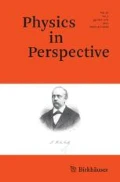Abstract
We provide a guide to Bologna, Italy, focusing particularly on sites of interest to physicists. Our first tour is in the city center; it begins in the Piazza Maggiore at the Palazzo d’Accursio, the Basilica di San Petronio, and the Archiginnasio (Old University) and then proceeds to the Two Towers and the Palazzo Poggi, which houses the Astronomical Observatory Museum and other important instrument and art collections; it concludes at the Physics Museum, Department of Physics and Astronomy. Our second tour again begins in the Piazza Maggiore but goes to sites beyond the city center where famous Bolognese physicists and other scientists were born, lived, and are buried. Finally, we point out important museums and other institutions on the outskirts of Bologna.















Similar content being viewed by others
Notes
The actual correct figure is 10 millimeters.
Website <http://www.museopalazzopoggi.unibo.it/>.
Website <http://www.sma.unibo.it/>.
Website <http://www.fisica-astronomia.unibo.it/>.
.
Website <http://www.museopelagalli.com/>.
Website <http://www.ducati.com/>.
Website <http://centrovisite.ira.inaf.it/>.
Website <http://www.genusbononiae.it/>.
The major art museums are the Pinacoteca Nazionale di Bologna, the Museo Civico Archeologico, the Museo Civico Medievale, the Raccolte d'Arte Civiche, the Museo di Palazzo d'Accursio, and the Museo d'Arte Moderna di Bologna.
References
Saecularia nona. Università di Bologna 1088–1988 (Bologna: Grafis, 1993).
Carlo Dolcini, ed., Università e studenti a Bologna nei secoli XIII e XIV (Torino: UTET, 1988).
Gian Paolo Brizzi, Lino Marini, and Paolo Pombeni, ed., L’Università a Bologna: Maestri, studenti e luoghi dal XVI al XX secolo (Cassa di Risparmio in Bologna: Amilcare Pizzi, 1988).
J.L. Heilbron, The Sun in the Church: Cathedrals as Solar Observatories (Cambridge, Mass. and London: Harvard University Press, 1999), pp. 73–74.
Christopher M. Graney, “Anatomy of a fall: Giovanni Battista Riccioli and the story of g,” Physics Today 65 (September 2012), 36–40, on 38–39.
Christopher M. Graney, “Contra Galileo: Riccioli’s ‘Coriolis Force’ Argument on the Earth’s Diurnal Rotation,” Physics in Perspective 13 (2011), 387–400.
Sistema Museale d’Ateneo, Guida ai 13 Musei Universitari di Bologna (Bologna: Minerva Edizioni, 2004).
Giuseppe Gaetano Bolletti, Dell’origine e dei progressi dell’Istituto delle scienze di Bologna (Bologna: Stamperia di Lelio dalla Volpe, 1751; reprinted Bologna: Cooperativa Libraria Universitaria, 1977).
Louis Ferdinand Comte de Marsilli, Histoire physique de la mer (Amsterdam: Aux de’Pens de la Compagnie, 1725); reprinted and edited by Giorgio Dragoni with an English translation by A. McConnell (Bologna: Museo di Fisica, University of Bologna, 1999).
Walter Tega, ed., Guida al Museo di Palazzo Poggi: Scienza e Arte (Bologna: Editrice Compositori, 2007).
Giorgio Dragoni, Per una Storia della Fisica a Bologna (Bologna: Bononia University Press, 2010).
Niels Bohr, “Biology and Atomic Physics” [1937], in Atomic Physics and Human Knowledge (New York: John Wiley & Sons and London: Chapman & Hall, 1958), pp. 13–22, on p. 13.
Giorgio Dragoni, “Il Museo di Fisica,” in Storia Illustrata di Bologna, I Musei dell’Università, 8/VII (Milano: AIEP, 1987), p. 154.
Giorgio Dragoni, Giulio Maltrese, and Luisa Atti, “Quirino Majorana’s Experiments on the Speed of Light and Gravitational Absorption,” Phys. in Perspec. 9 (2007), 281–304.
Giorgio Dragoni, “La ricostituzione del Museo dell’Istituto di Fisica dell’Università di Bologna,” in Ricerche dell’Istituto per i beni artistici, culturali, naturali della Regione Emilia-Romagna, No. 10 (Bologna: Nuova Alfa, 1983), pp. 33–75.
Francesco Maria Grimaldi, Physico-Mathesis de Lvmine, Coloribvs, et Iride, aliisqve adnexis, libri dvo … (Bononiæ: Ex Typographia Hæredis Victorij Benatij, 1665).
Adriano Ducati, Le onde corte nelle comunicazioni radioelettriche (Bologna: Nicola Zanichelli, 1927).
Acknowledgments
We thank Roger H. Stuewer for his careful and knowledgeable editorial work on our paper. We also thank Silvio Bergia and Attilio Forino of the University of Bologna for their kind advice.
Author information
Authors and Affiliations
Corresponding author
Additional information
Giorgio Dragoni is Professor of History of Physics at the University of Bologna. Ivana Stojanovic has a Masters degree in Molecular Biotechnology.
Rights and permissions
About this article
Cite this article
Dragoni, G., Stojanovic, I. Physical Science in Bologna. Phys. Perspect. 15, 92–115 (2013). https://doi.org/10.1007/s00016-013-0108-2
Published:
Issue Date:
DOI: https://doi.org/10.1007/s00016-013-0108-2
Keywords
- Giovanni Battista Amici
- Laura Bassi
- Gilberto Bernardini
- Rita Brunetti
- Giosuè Carducci
- Gian Domenico Cassini
- Nicolaus Copernicus
- Egnazio Danti
- Adriano Cavalieri Ducati
- Luigi Galvani
- Francesco Maria Grimaldi
- Marcello Malpighi
- Luigi Ferdinando Marsigli
- Pope Benedict XIV
- Pope Gregory XIII
- Pope Pius IX
- Giovanni Battista Guglielmini
- Ettore Majorana
- Quirino Majorana
- Guglielmo Marconi
- Macedonio Melloni
- Leopoldo Nobili
- Domenico Maria Novara
- Giovanni Pelagalli
- Giampietro Puppi
- Giovanni Battista Riccioli
- Augusto Righi
- Giorgio Valle
- Giuseppe Veratti
- Alessandro Volta
- Basilica di San Petronio
- Two Towers
- Archiginnasio
- University of Bologna
- Institute of Bologna
- Palazzo Poggi
- Astronomical Observatory Museum
- Physics Museum
- Museum of Industrial Heritage
- Pelagalli Museum
- Ducati Museum
- Northern Cross Radiotelescope
- Marconi Museum
- Villa Griffone
- Montecuccolino Nuclear Engineering Laboratory
- Genus Bononiae Museums in the City
- wireless telegraphy
- history of astronomy
- history of physics




